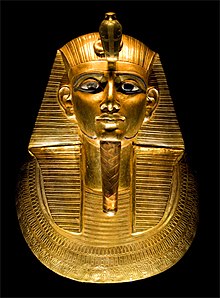Psusennes I
| Psusennes I | |
|---|---|
| Pasebakhenniut I | |

Gold burial mask of King Psusennes I, discovered in 1940 by Pierre Montet
|
|
| Pharaoh | |
| Reign | 1047 – 1001 BCE (21st Dynasty) |
| Predecessor | Amenemnisu |
| Successor | Amenemope |
| Consort | Mutnodjmet, Wiay |
| Children | Amenemope, AnkhefenMut, Isitemkheb |
| Father | Pinedjem I |
| Mother | Henuttawy |
| Died | c. 1001 BCE |
| Burial | NRT III, Tanis |
| Monuments | Great Temple of Amun, Tanis (now in ruined fragments) |
Psusennes I (Greek Ψουσέννης) was the third pharaoh of the 21st Dynasty who ruled from Tanis between 1047 – 1001 BC. Psusennes is the Greek version of his original name Pasibkhanu or Hor-Pasebakhaenniut (Egyptian ḥor-p3-sib3-ḫˁỉ-<n>-niwt) which means "The Star Appearing in the City" while his throne name, Akheperre Setepenamun, translates as "Great are the Manifestations of Ra, chosen of Amun." He was the son of Pinedjem I and Henuttawy, Ramesses XI's daughter by Tentamun. He married his sister Mutnedjmet.
Professor Pierre Montet discovered pharaoh Psusennes I's intact tomb (No.3 or NRT III) in Tanis in 1940. Unfortunately, due to its moist Lower Egypt location, most of the "perishable" wood objects were destroyed by water — a fate not shared by KV62, the tomb of Tutankhamun in the drier climate of Upper Egypt. However, the king's magnificent funerary mask was recovered intact; it proved to be made of gold and lapis lazuli and held inlays of black and white glass for the eyes and eyebrows of the object. Psusennes I's mask is considered to be "one of the masterpieces of the treasure[s] of Tanis" and is currently housed in Room 2 of the Cairo Museum. It has a maximum width and height of 38 cm and 48 cm respectively. The pharaoh's "fingers and toes had been encased in gold stalls, and he was buried with gold sandals on his feet. The finger stalls are the most elaborate ever found, with sculpted fingernails. Each finger wore an elaborate ring of gold and lapis lazuli or some other semiprecious stone."
Psusennes I's outer and middle sarcophagi had been recycled from previous burials in the Valley of the Kings through the state-sanctioned tomb-robbing that was common practice in the Third Intermediate Period. A cartouche on the red outer sarcophagus shows that it had originally been made for Pharaoh Merenptah, the 19th Dynasty successor of Ramesses II. Psusennes I, himself, was interred in an "inner silver coffin" which was inlaid with gold. Since "silver was considerably rarer in Egypt than gold," Psusennes I's silver "coffin represents a sumptuous burial of great wealth during Egypt's declining years."
...
Wikipedia
